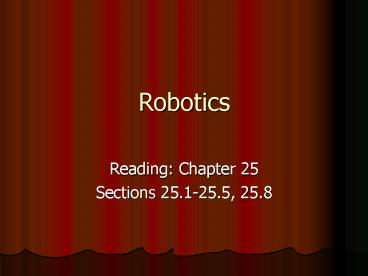Robotics - PowerPoint PPT Presentation
1 / 35
Title:
Robotics
Description:
Proprioceptive Sensors those that tell the robot about its own state ... Algorithm: Kalman filter: Resolve a system of matrices to determine positions ... – PowerPoint PPT presentation
Number of Views:78
Avg rating:3.0/5.0
Title: Robotics
1
Robotics
- Reading Chapter 25
- Sections 25.1-25.5, 25.8
2
Robotics
- Types of Robots, Sensors, Effectors
- Movement Degrees of Freedom, legs, wheels, power
sources - Robotic Tasks
- Localization
- Mapping
- Movement Planning
- Configuration spaces
- Robust Methods
- Application Domains
3
Stuff We Already Know
- Robots have
- Sensors (ways to get input)
- Cameras
- Ultrasound
- Effectors (ways to act and change the world)
- Wheels
- Grippers
4
Three Types
- Manipulators
- Robot Arms
- Tied to their environment
- Heavily used in factories
- Mobile Robot
- Unmanned cars, planes, subs
- Mars Rover
- Humanoid Robot
- Looks person-like
- Prosthetics
5
Types of Sensors
- Passive Dont involve the environment
- Cameras
- Active Change the environment in some way
- Sonar
6
More Sensor Categories
- Range Finders
- Short distance Tactile Sensors (Bumpers)
- Medium distance Sonar, Laser, Radar
- Long distance GPS
7
More Sensor Categories
- Imaging Sensors (Cameras)
- Proprioceptive Sensors those that tell the
robot about its own state - Rotation Sensors
- Odometers
- Force Torque Sensors
8
Effectors Degrees of Freedom
- DOF ways that an arm can move
- Example elbow (1) vs wrist (3)
- Prismatic Joints moving in x-y direction
- Revolute Joints rotation
9
Effective DOF
- Car has 2 DOF (back forward, steering wheel)
- Cant drive sideways, but I can parallel park!
- Cars have 3 effective DOF
- Holonomic Effective DOF DOF
- Non-holonomic Effective DOF gt DOF
10
Legs and Wheels
- Wheels are more stable and can move quicker
- Legs cover rough terrain, but are harder to build
- Currently, robots can walk, run, and jump
11
Power Sources
- Most popular Electric Motor
- Hydraulic actuators (water pressure)
- Pneumatic actuators (air pressure)
12
Localization
- Localization Finding where things are
- Tracking Know objects initial position, keep up
as it moves - Global Positioning Initial position is unknown.
Once its found, track it - Kidnapping Problem Object to be localized is
removed from the environment - Landmarks Non-moving objects whose positions are
known and which are recognizable
13
Keeping up with the robots position
Simplest model kinematic model Show x,y position
and angle of movement Take noise from actuators
into account by finding landmarks
14
Monte Carlo Localization
- Particles Points representing possible positions
- Trying to change position or using sensors makes
some positions more possible than others - Particles cluster into areas of high probability
- Example http//www.cs.washington.edu/ai/Mobile_Ro
botics/mcl/
15
Mapping
- Mapping is the problem of many objects in the
world - Dont know the landmark positions ahead of time
- SLAM Simultaneous Localization and Mapping
- Must construct a map of the environment without
knowing where it is itself - Algorithm Kalman filter Resolve a system of
matrices to determine positions
16
Extended Kalman Filtering (1)
17
EKF (2)
18
EKF(3)
19
EKF (4)
20
Planning Movement
- Point-to-point motion problem
- Compliant motion problem robot is in contact
with an obstacle - First problem How do we represent the space we
can move around in? - Cant use grid from vacuum world
- (Why not?)
21
Example
2 Degrees of Freedom Rotation of shoulder
and Rotation of elbow
22
Configuration Space
- Could use coordinates of arm and gripper, but
this doesnt take into account the constraints
between the two - Use instead the configuration space
representation keep track of the angles of
shoulder and elbow - Coordinate transformation as robot moves is
kinematics - Calculate the robot configuration given the
coordinates inverse kinematics
23
Plot the Configuration Space
Table Left Wall Vertical Obstacle Three configs
from first picture
f elbow
f shoulder
24
Cell Decomposition
- Create cells that represent the space.
- Use value iteration to learn the path from
beginning configuration to goal configuration.
25
Cell Decomposition
- Problem Hard to get around sharp corners
- Problem Result keeps as close to the object as
possible to shorten the path length this isnt
always a good idea - Cell decomposition is incomplete and unsound
(why?)
26
Cell Decomposition Answer
27
Better Way Potential Fields
- Define a potential field function over free
space, value grows with the distance to the
nearest object. - Now weigh the two solutions simultaneously stay
away from obstacles and take a short path
28
Potential Fields
Potential Field showing distance to obstacles
Solution using shortest path potential fields
29
Robust Methods
- There is uncertainty in all robotic movements
- In fine movements (small parts) the uncertainty
results in failure of the task - Fine Motion Planning Keep an envelope of
potential error, and plan for them
30
Put the Peg in the Hole
Its not as easy as just moving down with some
velocity. Chances are the peg will miss the hole.
31
Better Way
Instead, deliberately miss to the left of the
hole
And slide peg down and to the right.
32
Application Domains
- Industry and Agriculture
- Assembly Line
- Welding and Painting
- Harvesters and Mine
- Transportation
- Autonomous transport
- Automatic wheelchairs
- Indoor gofers
- Still require artificial localization aids
33
Application Domains
- Hazardous Environments
- Search Rescue
- Nuclear Waste cleanup
- Defusing Bombs
- Exploration
- Mars
- Abandoned Mines
- Drones unmanned air vehicles (military)
34
Application Domains
- Health Care
- Robotics to assist surgeons
- Doing delicate procedures
- Personal Services
- Vacuum cleaners
- Golf Caddies
- Lawn Mowers
35
Application Domains
- Entertainment
- Toys
- Games
- RoboCup
- Human Augmentation
- Prosthetics
- Teleoperation































